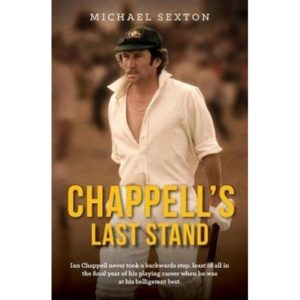Ian Chappell and his life as a cricketer
BOOK REVIEW
Chappell’s Last Stand by Michael Sexton, published by Affirm Press, Australia, 288 pages, RRP $29.99.
Reviewed by Kersi Meher-Homji
Besides being a resolute batsman and one of all-time great cricket captains, Ian Chappell has been the voice of cricket for many decades. He led his teams, Australia and South Australia, with vim and dynamism on and off the field. He suffered no fools and was blunt as much with his words as he was with his bat.
Michael Sexton’s recent book on Ian Chappell emphasises his twilight years as a cricketer.
Cricket lovers know almost all about his Test career ”“ especially against India ”“ and his captaincy record. This book is different as it zooms on his last year as a player in the Sheffield Shield. In that 1975-76 season, he took South Australia (SA) from wooden spoon shame to Shield glory.
The path was not easy. To defeat opponents was not as difficult as appeasing the SA administrators. But with support from his team mates, young and experienced, he triumphs. Not only by lifting the Trophy, beating Queensland led by brother Greg Chappell, but also making the administrators see his way.
ABC journalist Sexton interviews all his SA team mates ”“ Ashley Mallett, Terry Jenner better known as TJ, David Hookes, Rodney Hogg, Gary Cosier, Rick Darling, Dennis Yagmich, Wayne ”˜Fang’ Prior… from SA and the more legendary Australian Test players Dennis Lillee, Jeff Thomson, Rod Marsh as also brothers Greg and Trevor.
And don’t think that Australians sledged only Indians and players from other countries. In Shield cricket it is just as vitriolic. Detailed are blood and thunder encounters between Lillee mercilessly bouncing Mallett in a Shield match between Western Australia and SA and exchanging strong sledges.
Humour also laces the book. After brothers Ian and Greg had captained a Shield match against each other for SA and Queensland respectively, Ian received a call from his mother. To her question as to how it went, Ian replied that they had been arguing within five minutes of the match starting.
She asked, “What took you so long?”!
This is how the hot-tempered Rodney Hogg summed up Ian Chappell, “You did what he said…. Some stuff captains say you don’t pay attention to, but Ian may say the same thing and you listened ”“ because it was Ian.”
I see many parallels between Chappelli (Ian Chappell’s nickname) and Virat Kohli; strong-willed, gunning for a fight but inspirational.
The author quotes the great Garry Sobers: “I played with Ian [Chappell] as a young man and saw him in the South Australian dressing room even before he played for SA. He used to come in and listen for hours and hours to the fellows talk about the game. He was always a student of the game and the type of person who was always going to be a good captain.”
The book covers many other contemporary facets of Chappelli’s twilight era. In 1976 there are whispers of Kerry Packer’s World Series Cricket about to be born. As also the tragedy on how David Hookes, aged only 48, got killed outside a bar, knocked down by a security guard.
The book thus mixes the lofty with the unpleasant. The focus of the book is however on Chappelli lifting SA from the bottom to the top of Sheffield Shield in 1975-76 despite a threatened strike action by players against administrators who supported their captain on and off the field.
My one disappointment with Chappell’s Last Stand is that there are no photos inside. One might argue that with author Michael Sexton drawing poignant word pictures, there is no need for a camera.
Short URL: https://indiandownunder.com.au/?p=10104

